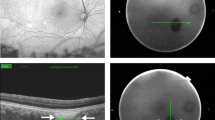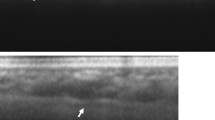Abstract
Purpose
The purpose was to illustrate small melanocytic choroidal tumors with speckle-noise free swept-source optical coherence tomography (SSOCT).
Methods
Twenty-five small melanocytic choroidal tumors in 24 eyes underwent 1050 nm OCT. All tumors were measured manually with the built-in caliper tool and compared to data derived from a semiautomated algorithm that removed speckle noise but preserved the structure of the tumors from the SSOCT data.
Results
The average manual measurements for the horizontal, vertical, and axial diameters were 1535.28 μm (range, 547–2807 μm), 1713.8 μm (range, 574–3921 μm), and 227.28 μm (range, 115–489 μm), respectively. The measured average volumes of the tumors were 835,248,212 μm3 (range, 48,818,700 to 4,567,401,810 μm3) and 228,588,535 μm3 (range, 22,879,641 to 787,668,886 μm3) for caliper measurements, respectively, for the extracted volumes. The average volume variation between the two methods was 66.16 % (range, 46.5 % to 82.75 %). The average ratio between the caliper and extracted volumes was 3.402 (range, 1.346–8.198, SD 1.681), 2.367 (range, 1.346–3.258, SD 0.618), 2.321 (range, 1.346–3.258, SD 0.611), 2.402 (range, 1.518–3.258, SD 0.591), and 1.749 (range, 1.518–1.733, SD 0.239) for all tumors, all tumors with the exclusion of extreme parameters, tumor <3 mm, tumor <2 mm, and tumor <1 mm, respectively. The average ratio (tumor index) between the tumor volume and the choroidal vessel volume was 12.539 (range, 0.489–73.701).
Conclusion
Speckle-noise free swept-source OCT may be an illustrative OCT imaging technology. OCT may be useful for describing and monitoring small melanocytic choroidal tumors and the choroidal vessels.





Similar content being viewed by others
References
Singh AD, Topham A (2003) Incidence of uveal melanoma in the United States: 1993–1997. Ophthalmology 110:956–961
Shields CL, Kaliki S, Furuta M et al (2012) Clinical spectrum and prognosis of uveal melanoma based on age at presentation in 8033 cases. Retina 32:1363–1372
Eskelin S, Pyrhonen S, Summanen P et al (2000) Tumor doubling times in metastatic malignant melanoma of the uvea. Tumor progression before and after treatment. Ophthalmology 107:1443–1449
Shields CL, Kaliki S, Furuta M et al (2013) American Joint Committee on Cancer classification of uveal melanoma (tumor size category) predicts prognosis. Analysis of 7731 patients. Ophthalmology 120:2066–2071
Singh AD, Kalyani P, Topham A (2005) Estimating the risk of malignant transformation of a choroidal nevus. Ophthalmology 112:1784–1789
Shields CL, Kels JG, Shields JA (2015) Melanoma of the eye: revealing hidden secrets, one at a time. Clin Dermatol 33(2):183–196. doi:10.1016/j.clindermatol.2014.10.010
Kernt M, Schaller UC, Stumpf C, Ulbig MW, Kampik A, Neubauer AS (2010) Choroidal pigmented lesions imaged by ultra-wide-field scanning laser ophthalmoscopy with two laser wavelengths (Optomap). Clin Ophthalmol 30(4):829–836
Spaide RF, Koizumi H, Pozzoni MC (2009) Enhanced depth imaging spectral-domain optical coherence tomography. Am J Ophthalmol 146(4):496–500, Erratum in Am J Ophthalmol 148(2):325
Shields CL, Kaliki S, Rojanaporn D, Ferenczy SR, Shields JA (2012) Enhanced depth imaging optical coherence tomography of small choroidal melanoma: comparison with choroidal nevus. Arch Ophthalmol 130(7):850–856
Alonso-Caneiro D, Read SA, Collins MJ (2013) Automatic segmentation of choroidal thickness in optical coherence tomography. Biomed Opt Express 4(12):2795–2812
Kajić V, Esmaeelpour M, Považay B, Marshall D, Rosin PL, Drexler W (2012) Automated choroidal segmentation of 1060 nm OCT in healthy and pathologic eyes using a statistical model. Biomed Opt Express 3(1):86–103
Esmaeelpour M, Kajic V, Zabihian B et al (2014) Choroidal Haller’s and Sattler’s layer thickness measurement using 3-dimensional 1060-nm optical coherence tomography. PLoS One 9(6):e99690. doi:10.1371/journal.pone.0099690
Girard MJ, Strouthidis NG, Ethier CR, Mari JM (2011) Shadow removal and contrast enhancement in optical coherence tomography images of the human optic nerve head. Invest Ophthalmol Vis Sci 52(10):7738–7748
Gyger C, Hasler P, Cattin R, Maloca P (2014) Three-dimensional speckle reduction in optical coherence tomography through structural guided filtering. Opt Eng 53(7):073105. doi:10.1117/1.OE.53.7.073105
Pizer SM, Amburn EP, Austin JD et al (1987) Adaptive histogram equalization and its variations. Comput Vision Graph 39:355–368
Staurenghi G, Sadda S, Chakravarthy U, Spaide RF (2014) International nomenclature for optical coherence tomography. Ophthalmology. doi:10.1016/j.ophtha.2014.02.023
Spaide RF, Fujimoto JG, Waheed NK (2015) Image artifacts in optical coherence tomography angiography. Retina 35(11):2163–2180. doi:10.1097/IAE.0000000000000765
Francis JH, Pang CE, Abramson DH, Milman T, Folberg R, Mrejen S, Freund KB (2015) Swept-source optical coherence tomography features of choroidal nevi. Am J Ophthalmol 159(1):169–176.e1. doi:10.1016/j.ajo.2014.10.011
Shields CL, Furuta M, Berman EL, Zahler JD, Hoberman DM, Dinh DH et al (2009) Choroidal nevus transformation into melanoma: Analysis of 2514 consecutive cases. Arch Ophthalmol 127:981–987
The Collaborative Ocular Melanoma Study Group (1997) Factors predictive of growth and treatment of small choroidal melanoma: COMS report no 5. Arch Ophthalmol 115:1537–1544
Doro D, Kotsafti O, Cimatti P (2013) Long-term echographic surveillance of elevated choroidal nevi. Am J Ophthalmol 156(3):438–443
Basdekidou C, Wolff B, Vasseur V, Mer YL, Sahel JA (2011) Flat choroidal nevus inaccessible to ultrasound sonography evaluated by enhanced depth imaging optical coherence tomography. Case Rep Ophthalmol 2(2):185–188
Sumich P, Mitchell P, Wang JJ (1998) Choroidal nevi in a white population: the Blue Mountains Eye Study. Arch Ophthalmol 116:645–650
Say EA, Shah SU, Ferenczy S, Shields CL (2012) Optical coherence tomography of retinal and choroidal tumors. J Ophthalmol 2012:385058
Tan CS, Ouyang Y, Ruiz H, Sadda SR (2012) Diurnal variation of choroidal thickness in normal, healthy subjects measured by spectral domain optical coherence tomography. Invest Ophthalmol Vis Sci 53(1):261–266. doi:10.1167/iovs.11-8782
Maloca P, Gyger C, Hasler WP (2015) Ultra-short-term reproducibility of speckle-noise freed fluid and tissue compartmentalization of the choroid analyzed by standard spectral OCT. Transl Vis Sci Technol 4(6):3
Maloca P, Gyger C, Schoetzau A, Hasler PW (2015) Inter-device size variation of small choroidal nevi measured using stereographic projection ultra-widefield imaging and optical coherence tomography. Graefes Arch Clin Exp Ophthalmol. doi:10.1007/s00417-015-3209-6
Author information
Authors and Affiliations
Corresponding author
Ethics declarations
Funding
No funding was received for this research.
Conflict of interest
Peter Maloca and Cyrill Gyger are owners of the intellectual property of the speckle-noise analysis technology discussed in this manuscript. Peter Maloca and Pascal Hasler are consultants and have received lecture fees from Mediconsult/Topcon and Optos. The funding organizations had no role in the design or conduct of the current study. All authors certify that, except as indicated above, they have NO affiliations with or involvement in any organization or entity with any financial interest (such as honoraria; educational grants; participation in speakers’ bureaus; membership, employment, consultancies, stock ownership, or other equity interest; and expert testimony or patent-licensing arrangements), or non-financial interest (such as personal or professional relationships, affiliations, knowledge or beliefs) in the subject matter or materials discussed in this manuscript.
Ethical approval
All procedures performed in studies involving human participants were in accordance with the ethical standards of the institutional and/or national research committee and with the 1964 Declaration of Helsinki and its later amendments or comparable ethical standards. Informed consent was obtained from all individual participants included in the study.
Rights and permissions
About this article
Cite this article
Maloca, P., Gyger, C. & Hasler, P.W. A pilot study to compartmentalize small melanocytic choroidal tumors and choroidal vessels with speckle-noise free 1050 nm swept source optical coherence tomography (OCT choroidal “tumoropsy”). Graefes Arch Clin Exp Ophthalmol 254, 1211–1219 (2016). https://doi.org/10.1007/s00417-016-3270-9
Received:
Revised:
Accepted:
Published:
Issue Date:
DOI: https://doi.org/10.1007/s00417-016-3270-9




